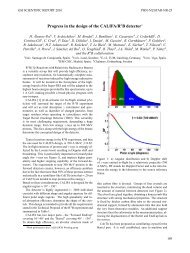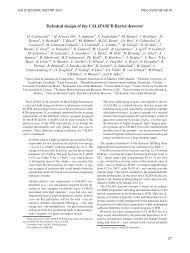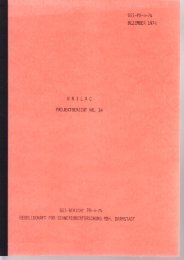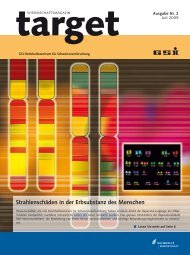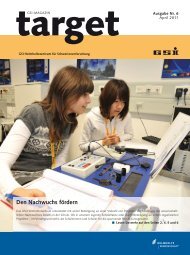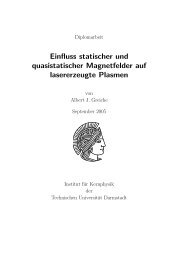download block - GSI Helmholtzzentrum für Schwerionenforschung
download block - GSI Helmholtzzentrum für Schwerionenforschung
download block - GSI Helmholtzzentrum für Schwerionenforschung
You also want an ePaper? Increase the reach of your titles
YUMPU automatically turns print PDFs into web optimized ePapers that Google loves.
<strong>GSI</strong>-UPGRADE-ACC-07 <strong>GSI</strong> SCIENTIFIC REPORT 2009<br />
Simulation and observation of the space charge induced multi-stream<br />
instability of linac micro bunches in the SIS-18 synchrotron<br />
S. Appel 1 , O. Boine-Frankenheim 2 , and Th. Weiland 1<br />
1 TEMF, TU Darmstadt, Germany; 2 <strong>GSI</strong>, Darmstadt, Germany<br />
For the upgrade of the SIS-18 synchrotron it is of importance<br />
that the initial momentum spread of the injected<br />
coasting beam does not exceed the limit set by the rf bucket<br />
area. The lower limit is determined by microwave instabilities<br />
which cause a sudden increase of the momentum<br />
spread below a threshold momentum spread.<br />
For a coasting Ar 18+ beam in the SIS-18 the measured momentum<br />
spread as a function of the number of injected<br />
turns is shown in Fig.1. The momentum spread has been<br />
obtained from different Schottky bands.<br />
During the transverse multi-turn injection the SIS-18 is<br />
filled with micro bunches from the UNILAC linac at 36<br />
MHz. For low beam intensities the micro bunches debunch<br />
within a few turns and form a coasting beam with<br />
a Gaussian-like momentum spread distribution. With increasing<br />
intensity we observe a few 100 turns after injection<br />
persistent current fluctuations and an accompanying<br />
pseudo-Schottky spectrum.<br />
The Schottky spectrum should be used to routinely measure<br />
the momentum spread (see Fig.1) and revolution frequency<br />
directly after injection. Therefore is is important to understand<br />
the origin of the pseudo-Schottky spectrum.<br />
In [1] it is shown that the multi-stream instability induced<br />
by the space charge impedance leads to phase space turbulence<br />
with strong coherent fluctuation. The dispersion<br />
relation is<br />
qI0η<br />
−i<br />
2πγβ 2mc2 Zsc<br />
n<br />
n 2 ω 2 0<br />
M<br />
M�<br />
j=1<br />
1<br />
= 1, (1)<br />
(ω − kvj)<br />
from which the critical number of filaments results as<br />
Mthr = 32<br />
πUsc<br />
where Zsc is the space charge impedance, vj the velocity<br />
of the jth filament, Usc the space charge parameter and σ<br />
the momentum spread.<br />
The saturation of the instability causes persistent current<br />
fluctuations with a broad frequency spectrum. Such a fast<br />
transition to a broad frequency spectrum was observed in<br />
the SIS-18 shortly after injection of N = 10 9 Ar 18+ ions<br />
(Fig. 2) as well as in simulations. The transition occurs<br />
exactly after Mthr filaments have been generated.<br />
A simulation code has been developed which reproduces<br />
the important aspects of the observed instability, like the<br />
threshold number of filaments and the broadness of the<br />
spectrum after saturation. The code will be used to estimate<br />
the effect of other ring impedances on the beam momentum<br />
and on its spread.<br />
152<br />
(2)<br />
Figure 1: Rms momentum spread as a function of the<br />
number of injected turns measured from different Schottky<br />
bands. Approximately 10 9 Ar 18+ ions are injected per<br />
turn. A possible reason for the obtained increase are microwave<br />
instabilities.<br />
Figure 2: Measured frequency spectrum from N = 10 9<br />
Ar 18+ ions injected into SIS-18. The dashed line indicates<br />
the duration after which the broad frequency spectrum develops<br />
in the simulation. The solid line present the SIS-18<br />
beam pipe cut-off frequency.<br />
In addition the minimum momentum spread achievable in<br />
SIS-18 as well as the characteristics of the pseudo-Schottky<br />
noise will be analyzed using the code together with the experimental<br />
data.<br />
Experiments with the new SIS-18 broadband current transformer<br />
a planed for the upcoming beam times.<br />
References<br />
[1] I. Hofmann, <strong>GSI</strong> Note March 1989<br />
[2] S. Appel et al., DPG-Tagung München 2009





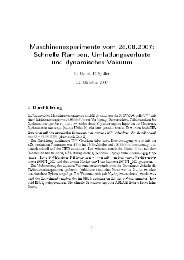
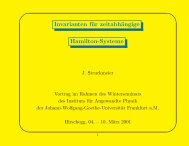
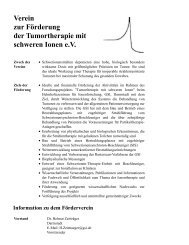
![GS I -P-]-17 - GSI Helmholtzzentrum für Schwerionenforschung](https://img.yumpu.com/20698964/1/184x260/gs-i-p-17-gsi-helmholtzzentrum-fur-schwerionenforschung.jpg?quality=85)

